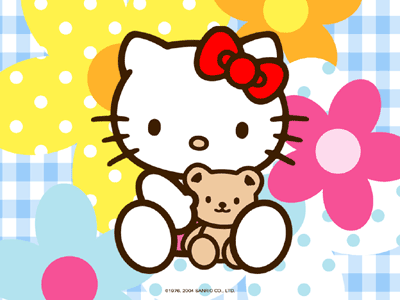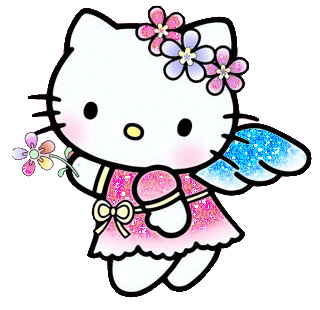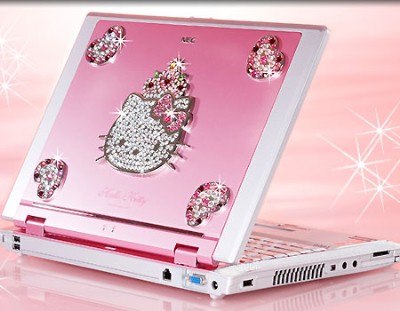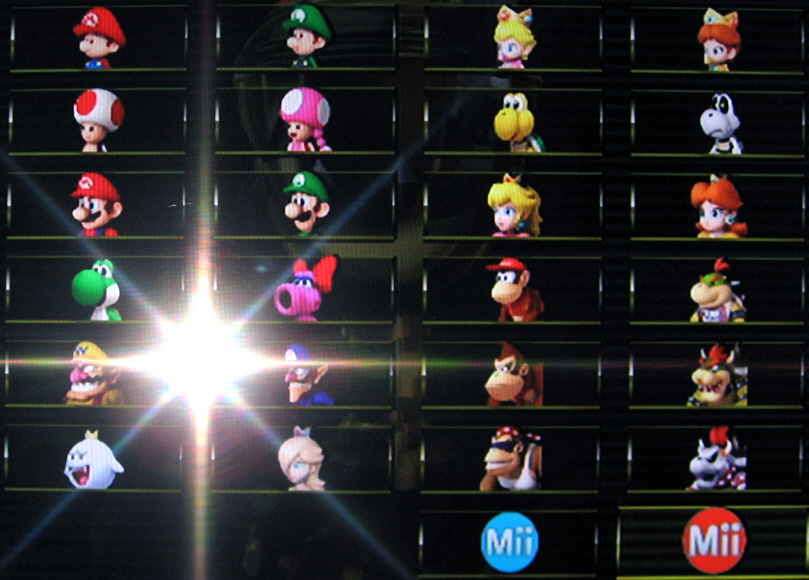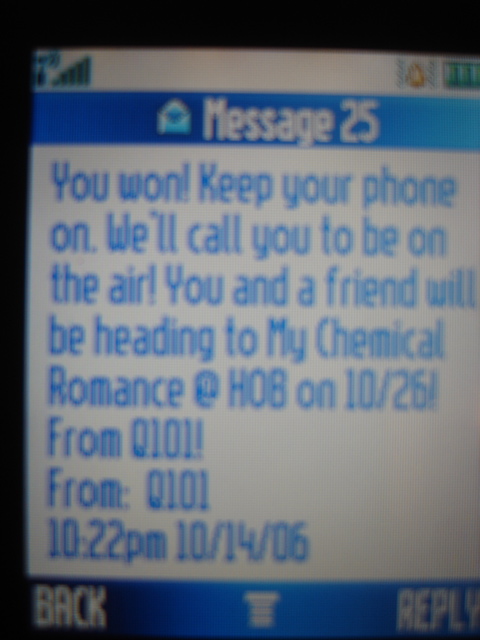The Adventures of Hello Kitty & Friends is a 3D CGI animated series from 2006 developed by Sanrio's digital entertainment entity Sanrio Digital.
There are several different Hello Kitty (ハローキティ, Harō Kiti?) TV series, featuring the character Hello Kitty, from the Japanese company Sanrio.
Hello Kitty's Paradise is an anime series which ran for 16 episodes (each episode consisted of two 15-minute cartoons) and was released in English in 2000. Available in the U.S. from ADV Films (who also own the video/DVD rights to Hello Kitty and Friends)
Hello Kitty's Stump Village is a Japanese clay-animated series from 2005. It is licsensed by Funimation Entertainment in North America.
Hello Kitty's Furry Tale Theater is an Japanese-American co-produced animated series. The series involved Hello Kitty and her friends doing their own version of popular fairy tales and stories. Each of the 13 half-hour episodes consisted of two 11-minute cartoons, for a total of 26 shows; each show was a spoof of a well-known fairy tale or movie.
Friday, October 28, 2011
then Mario Crossover
Apart from his platformer and spinoff-game appearances, Mario has made guest appearances in non-Mario games, such as Mike Tyson's Punch-Out!!, where Mario is a referee. Mario has also appeared as a playable character in NBA Street V3 and SSX on Tour, both by Electronic Arts. He makes cameo appearances in both The Legend of Zelda: A Link to the Past and The Legend of Zelda: Ocarina of Time as a portrait, and in Metal Gear Solid: The Twin Snakes, he appears as a small statue.
Mario went to 2.5D in New Super Mario Bros. While Mario and Peach take a walk together through the Mushroom Kingdom, Bowser Jr. kidnaps Peach and flees. Mario gives chase, venturing through eight worlds. Mario eventually catches up, defeating both Bowser and Bowser Jr. and rescuing Peach. In Super Mario Galaxy, Mario is invited by Princess Peach to the centennial Star Festival in the Mushroom Kingdom. Upon arrival, Bowser invades the kingdom and rips Peach's castle from its foundations and lifts it into outer space. After failing to prevent the princess from being kidnapped, Mario meets star-like creatures called Lumas and their companion, Rosalina. Rosalina tells Mario that Bowser has stolen the Power Stars, the source of power for Rosalina's mobile observatory, and has taken Peach to the center of the universe. Mario then travels to various galaxies to reclaim the Power Stars to restore power to the observatory and reclaim Princess Peach. In New Super Mario Bros. Wii, another 2.5D game, Mario, Luigi, and two Toads are attending Princess Peach's birthday party when Bowser Jr. and the other seven Koopalings ambush the princess and kidnap her. Mario, Luigi, and the two Toads chase after them across eight worlds, defeating each Koopaling as they progress. The quartet eventually confronts Bowser, defeating him and reclaiming the princess. In Super Mario Galaxy 2, Bowser, who has transformed himself into a giant using the Power Stars, attacks the Mushroom Kingdom and abducts Peach, taking her to the center of the universe. With the help of the Lumas, Mario pilots Starship Mario, a mobile planet in the shape of his head, in order to travel to various galaxies and gather the Power Stars, used to fuel the ship. After multiple battles against both Bowser and Bowser Jr., Mario eventually arrives at Bowser's lair at the center of the universe, where he defeats him and rescues the princess.
Mario made his 3D debut in Super Mario 64. Princess Peach sends Mario a letter inviting him to join her at her castle for cake; however, when he arrives, Mario discovers that Bowser has invaded the castle and imprisoned the princess and her servants within it using the castle's 120 Power Stars. Many of the castle's paintings are portals to other worlds, in which Bowser's minions guard the stars. Mario explores the castle and these other worlds to recover the stars. He gains access to more painting portals as he recovers more stars, and he traverses three obstacle courses that lead him to battles with Bowser. Defeating Bowser the first two times earns Mario keys that open new levels of the castle, while the final battle releases Peach, who rewards Mario by baking the cake that she promised him.
Video games:
Mario went to 2.5D in New Super Mario Bros. While Mario and Peach take a walk together through the Mushroom Kingdom, Bowser Jr. kidnaps Peach and flees. Mario gives chase, venturing through eight worlds. Mario eventually catches up, defeating both Bowser and Bowser Jr. and rescuing Peach. In Super Mario Galaxy, Mario is invited by Princess Peach to the centennial Star Festival in the Mushroom Kingdom. Upon arrival, Bowser invades the kingdom and rips Peach's castle from its foundations and lifts it into outer space. After failing to prevent the princess from being kidnapped, Mario meets star-like creatures called Lumas and their companion, Rosalina. Rosalina tells Mario that Bowser has stolen the Power Stars, the source of power for Rosalina's mobile observatory, and has taken Peach to the center of the universe. Mario then travels to various galaxies to reclaim the Power Stars to restore power to the observatory and reclaim Princess Peach. In New Super Mario Bros. Wii, another 2.5D game, Mario, Luigi, and two Toads are attending Princess Peach's birthday party when Bowser Jr. and the other seven Koopalings ambush the princess and kidnap her. Mario, Luigi, and the two Toads chase after them across eight worlds, defeating each Koopaling as they progress. The quartet eventually confronts Bowser, defeating him and reclaiming the princess. In Super Mario Galaxy 2, Bowser, who has transformed himself into a giant using the Power Stars, attacks the Mushroom Kingdom and abducts Peach, taking her to the center of the universe. With the help of the Lumas, Mario pilots Starship Mario, a mobile planet in the shape of his head, in order to travel to various galaxies and gather the Power Stars, used to fuel the ship. After multiple battles against both Bowser and Bowser Jr., Mario eventually arrives at Bowser's lair at the center of the universe, where he defeats him and rescues the princess.
Mario made his 3D debut in Super Mario 64. Princess Peach sends Mario a letter inviting him to join her at her castle for cake; however, when he arrives, Mario discovers that Bowser has invaded the castle and imprisoned the princess and her servants within it using the castle's 120 Power Stars. Many of the castle's paintings are portals to other worlds, in which Bowser's minions guard the stars. Mario explores the castle and these other worlds to recover the stars. He gains access to more painting portals as he recovers more stars, and he traverses three obstacle courses that lead him to battles with Bowser. Defeating Bowser the first two times earns Mario keys that open new levels of the castle, while the final battle releases Peach, who rewards Mario by baking the cake that she promised him.
Video games:
funny pictures text message
The Yellow Arrow symbol means ‘there’s more here: a hidden detail, a funny story, a memory, and a crazy experience.’ Each arrow links digital content to a specific location using the mobile phone. As an underground phenomenon, the project has grown a vibrant and tight community internationally. As of November 2008, 7535 Yellow Arrow stickers have been placed in 467 cities and 35 countries. Since appearing first on the streets of Manhattan's Lower East Side in May 2004, Yellow Arrow has been featured in The New York Times, Wired Magazine, Newsweek, The Washington Post, The Boston Globe, CNN and NBC, the London Times, Politiken, Liberation, Diari de Barcelona, and de Volkskrant. Yellow Arrow was also featured in Lonely Planet's Guide to Experimental book series.
Yellow Arrow is a global public art project in that began in New York, New York but has now spread globally. Yellow arrow stickers can be obtained from their website and placed anywhere in the public realm. When encountering a sticker on the street, one can send the unique code printed on it as a text message to a particular phone number. Moments later a text message will be received with a message left by the sticker's original owner.
Yellow Arrow is a global public art project in that began in New York, New York but has now spread globally. Yellow arrow stickers can be obtained from their website and placed anywhere in the public realm. When encountering a sticker on the street, one can send the unique code printed on it as a text message to a particular phone number. Moments later a text message will be received with a message left by the sticker's original owner.
Subscribe to:
Posts (Atom)



